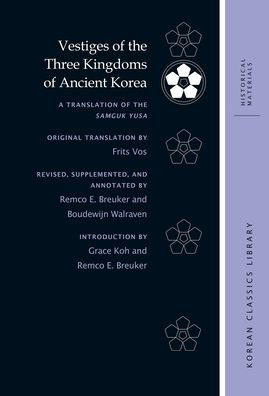Vestiges of the Three Kingdoms of Ancient Korea: A Translation of the Samguk yusa
Vestiges of the Three Kingdoms of Ancient Korea (Samguk yusa) is the first annotated English translation of one of the most important premodern Korean historical texts. One of only two surviving works on the Three Kingdoms period (57 BCE–668) and Greater Silla (668–936), the Samguk yusa is a rich collection of historical, supernatural, and mythical stories, including one of the earliest surviving narratives of Tan’gun, who in modern times came to be regarded as the mythical or legendary progenitor of the Korean people.
Compiled primarily in classical Chinese during the Koryŏ period (918–1392), the Samguk yusa is known for its idiosyncratic structure and eclectic content. Although strongly Buddhist in orientation and generally assumed to have been compiled in large part by the celebrated monk Iryŏn (1206–1289), the work also encompasses Confucianism, geomancy, secular history, and folklore. It was not highly regarded during the Chosŏn period (1392–1910) but re-emerged in the twentieth century as a Korean foundational text. Today the Samguk yusa is celebrated as a national treasure of native Korean tradition and heritage and continues to play a crucial role in forming Korean identity north and south of the border. References to it are commonplace in contemporary Korea, with new translations and adaptations of its narratives frequently published.
This annotated translation, the result of many years’ work by Frits Vos, a pioneer of Korean studies in Europe, and later colleagues, includes a critical introduction that illuminates the text's history, reception, and broader historical context and offers an analytical overview of the themes and literary strategy of the work.
1146782592
Compiled primarily in classical Chinese during the Koryŏ period (918–1392), the Samguk yusa is known for its idiosyncratic structure and eclectic content. Although strongly Buddhist in orientation and generally assumed to have been compiled in large part by the celebrated monk Iryŏn (1206–1289), the work also encompasses Confucianism, geomancy, secular history, and folklore. It was not highly regarded during the Chosŏn period (1392–1910) but re-emerged in the twentieth century as a Korean foundational text. Today the Samguk yusa is celebrated as a national treasure of native Korean tradition and heritage and continues to play a crucial role in forming Korean identity north and south of the border. References to it are commonplace in contemporary Korea, with new translations and adaptations of its narratives frequently published.
This annotated translation, the result of many years’ work by Frits Vos, a pioneer of Korean studies in Europe, and later colleagues, includes a critical introduction that illuminates the text's history, reception, and broader historical context and offers an analytical overview of the themes and literary strategy of the work.
Vestiges of the Three Kingdoms of Ancient Korea: A Translation of the Samguk yusa
Vestiges of the Three Kingdoms of Ancient Korea (Samguk yusa) is the first annotated English translation of one of the most important premodern Korean historical texts. One of only two surviving works on the Three Kingdoms period (57 BCE–668) and Greater Silla (668–936), the Samguk yusa is a rich collection of historical, supernatural, and mythical stories, including one of the earliest surviving narratives of Tan’gun, who in modern times came to be regarded as the mythical or legendary progenitor of the Korean people.
Compiled primarily in classical Chinese during the Koryŏ period (918–1392), the Samguk yusa is known for its idiosyncratic structure and eclectic content. Although strongly Buddhist in orientation and generally assumed to have been compiled in large part by the celebrated monk Iryŏn (1206–1289), the work also encompasses Confucianism, geomancy, secular history, and folklore. It was not highly regarded during the Chosŏn period (1392–1910) but re-emerged in the twentieth century as a Korean foundational text. Today the Samguk yusa is celebrated as a national treasure of native Korean tradition and heritage and continues to play a crucial role in forming Korean identity north and south of the border. References to it are commonplace in contemporary Korea, with new translations and adaptations of its narratives frequently published.
This annotated translation, the result of many years’ work by Frits Vos, a pioneer of Korean studies in Europe, and later colleagues, includes a critical introduction that illuminates the text's history, reception, and broader historical context and offers an analytical overview of the themes and literary strategy of the work.
Compiled primarily in classical Chinese during the Koryŏ period (918–1392), the Samguk yusa is known for its idiosyncratic structure and eclectic content. Although strongly Buddhist in orientation and generally assumed to have been compiled in large part by the celebrated monk Iryŏn (1206–1289), the work also encompasses Confucianism, geomancy, secular history, and folklore. It was not highly regarded during the Chosŏn period (1392–1910) but re-emerged in the twentieth century as a Korean foundational text. Today the Samguk yusa is celebrated as a national treasure of native Korean tradition and heritage and continues to play a crucial role in forming Korean identity north and south of the border. References to it are commonplace in contemporary Korea, with new translations and adaptations of its narratives frequently published.
This annotated translation, the result of many years’ work by Frits Vos, a pioneer of Korean studies in Europe, and later colleagues, includes a critical introduction that illuminates the text's history, reception, and broader historical context and offers an analytical overview of the themes and literary strategy of the work.
75.0
Pre Order
5
1

Vestiges of the Three Kingdoms of Ancient Korea: A Translation of the Samguk yusa
584
Vestiges of the Three Kingdoms of Ancient Korea: A Translation of the Samguk yusa
584Hardcover
$75.00
75.0
Pre Order

Product Details
| ISBN-13: | 9798880701858 |
|---|---|
| Publisher: | University of Hawaii Press, The |
| Publication date: | 10/31/2025 |
| Series: | Korean Classics Library: Historical Materials , #14 |
| Pages: | 584 |
| Product dimensions: | 6.00(w) x 9.00(h) x (d) |
About the Author
From the B&N Reads Blog
